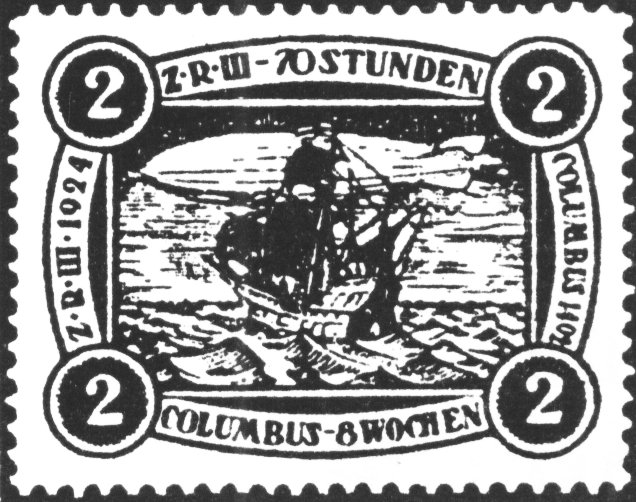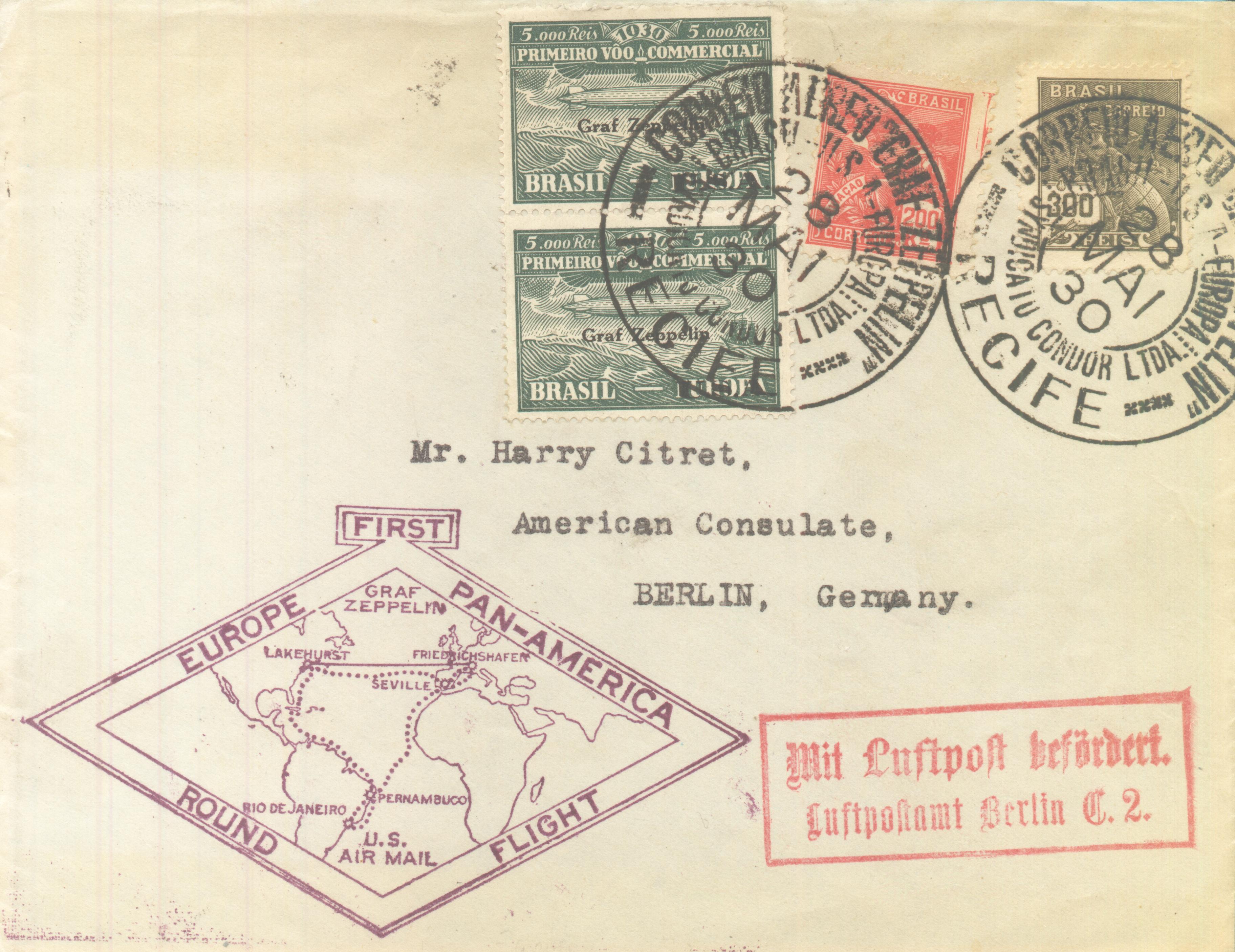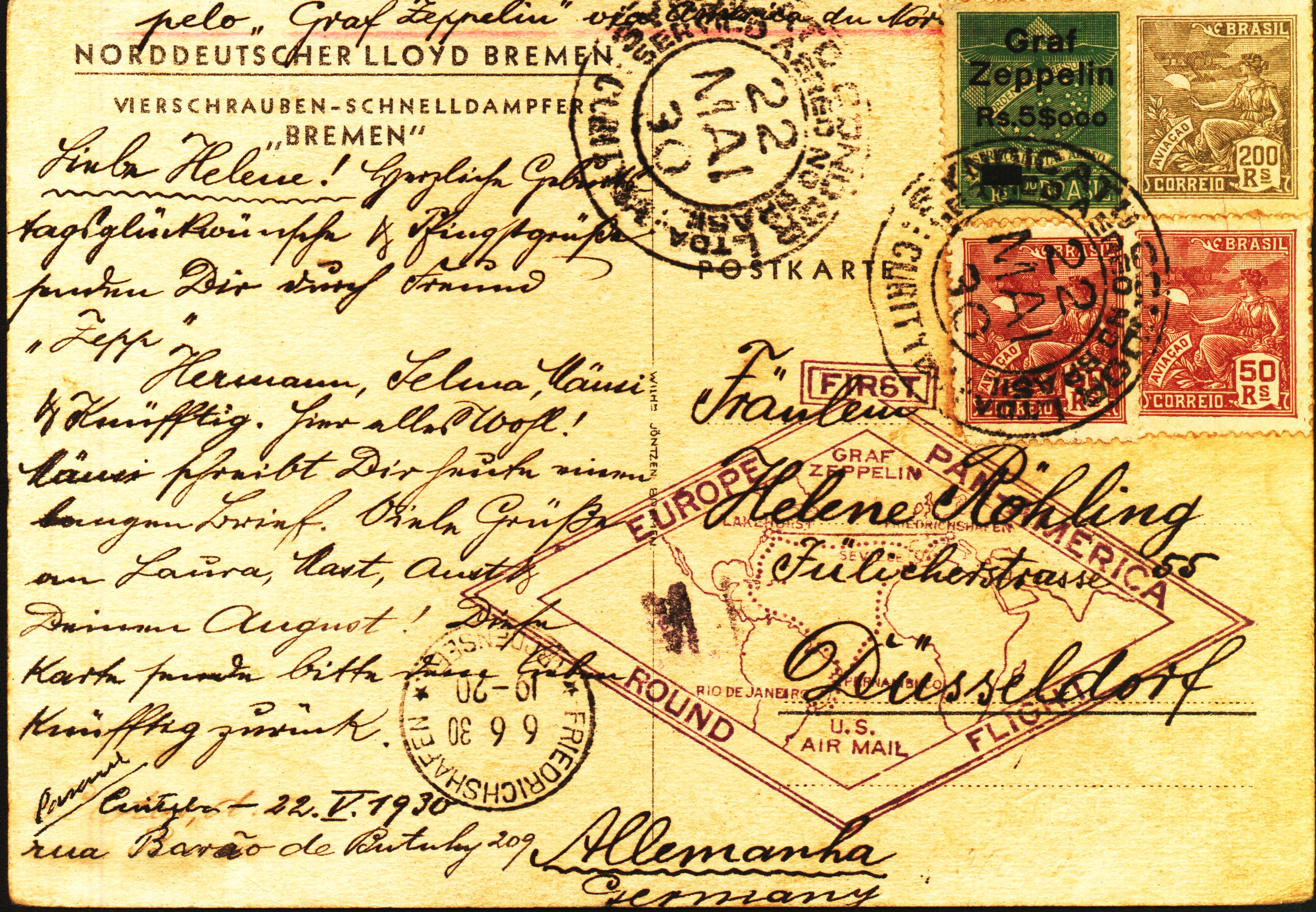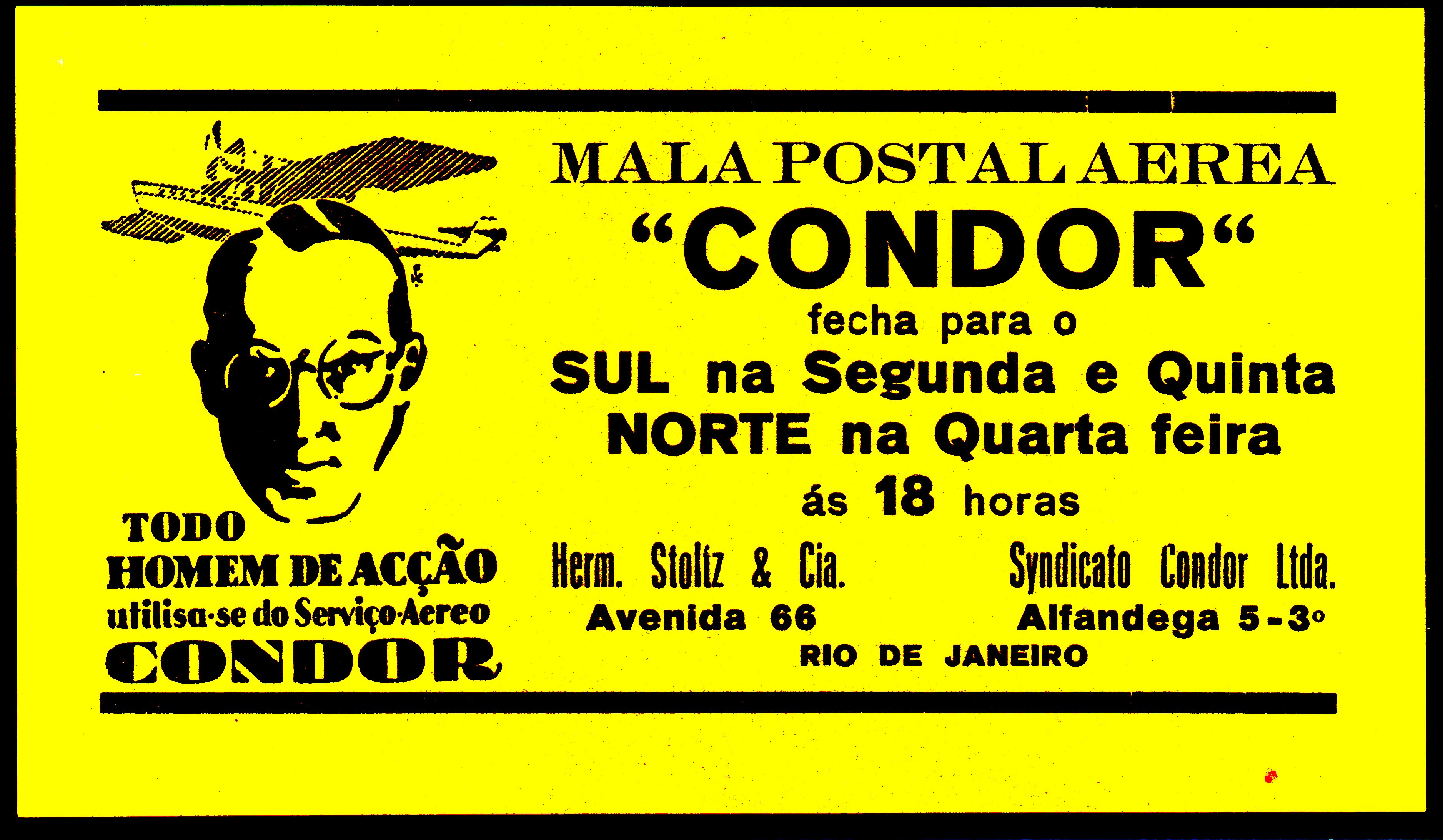 Figure 1: Example of the ZR3
Cinderella /7/.
Figure 1: Example of the ZR3
Cinderella /7/.|
© Dr. Artur Knoth |
Brazilian Philately: The Pan Am Zeppelin Flight of 1930 |
Condor/Zeppelin Stamps for the 1930 Pan Am Flight
Preface
When doing research in almost any field of philately, one soon realizes that some of the reference books and catalogs, of what ever you happen to be studying, contain some errors, or at the very least, slight inaccuracies. Often, so-called eye witnesses get it all wrong. or a typo keeps getting repeatedly copied in later editions and included in subsequent research as a given, proven and correct fact. With this initial article about the stamps issued in Brazil for use on this flight, I will demonstrate that, as in many of the other articles in this site, in some cases the catalogs /1-4,11/ get it wrong. I'll show where and why, and what the real thing is.
Precursor Issue?
When discussing how the design of the semi-private Condor-Zeppelin stamps on the 1930 Pan Am flight was chosen, often the ZR3 flight of 1924 and the famous Cinderella stamp (Fig. 1, /5-7/ associated with it gets mentioned. The ZR3 was part of the reparations paid to the USA for World War I, and the flight was to begin on the 12th of October 1924 from Seville, which, according to the Spanish Ambassador, was a “godly” similarity to the voyage of Columbus, while it was the same day in 1492 that America was discovered /8/. Soon after the flight had taken place, the Cinderella of Fig. 1 appeared with the Zeppelin in the background and the Santa Maria in the foreground. Also that Columbus took 8 weeks and the Zeppelin only 70 hours. The design was by Paul Landgraf /5/.
 Figure 1: Example of the ZR3
Cinderella /7/.
Figure 1: Example of the ZR3
Cinderella /7/.
The Initial Stamps
This and the accompanying article on the rates, are revised updated versions of an initial article published in the FFE-Journal #8 /9/. The main set of Condor-Zeppelin stamps consists of three values (Fig. 2), the 5$000 Reis in green, the 10$000 Reis in red and the 20$000 Reis in blue. The artist that produced the design was Dorothea Suffrian /11/ and whether she was influenced by the Landgraf design for the ZR3 can't be verified.
![]() Figure 2: The three basic
Condor-Zeppelin values.
Figure 2: The three basic
Condor-Zeppelin values.
The stamps were printed by the Reichsdruckerei Berlin, using German fiscal paper with the watermark (wmk) Crosses (Kreuzblüten-Wz or officially as Vierpaß-Wz – Fig.3),(see /10/, Michel Nr. 151Y – Reich), perforated 14.
![]() Figure 3: Watermark used for
the initial Condor-Zeppelin stamps.
Figure 3: Watermark used for
the initial Condor-Zeppelin stamps.
Due to the fact that a substantial amount of the mail on this flight would be headed to the USA, the Brazilian Postal Authorities requested that a part of the stamps be overprinted with USA over the Europa (and an additional “Graf Zeppelin” also was added for some reason) /11/.
![]() Figure 4: Initial set
overprinted with “Graf Zeppelin – U.S.A.”.
Figure 4: Initial set
overprinted with “Graf Zeppelin – U.S.A.”.
The overprinting was done locally, in Rio de Janeiro, by the printer Thomas & Paus Ltda. (THP also known as Tipografia Teutonia) /2,11,12/. Fig. 4 demonstrates this set of values. But in no way did this overprinting mean that unoverprinted stamps could not be used for mail to the USA or vice versa, all the statements at auctions of the use of non allowed versions on the wrong mail is pure nonsense /9/. This even though Berezowski states there was to be a “sorting” per destination, this being for the purposes of accounting (which? - since the official Brazilian postage was independent of the Zeppelin part). The issuance of the makeup stamps, without any reference to Europe or USA, belies the fact that the possibly originally intended separate bookkeeping didn't survive very long and everything type of franking was allowed. Figure 5 demonstrates nicely how a pair of 5$000-USA stamps were used on a cover to pay the letter rate to Germany.
 Figure 5: Use of “USA”
overprinted stamps on a letter to Europe.
Figure 5: Use of “USA”
overprinted stamps on a letter to Europe.
The Makeup Stamps
Soon after their initial emission date, it became very obvious that company was running out of the low value 5$000 stamps and shortly thereafter also the 10$000. Since the use of the 20$000 stamps very limited (see general rates or/9/), a large amount of the later was surcharged with 5$000 and 10$000 (Fig. 6). Again, the local printer was THP.
![]() Figure 6: 5$000 and 10$000
surcharges on the surplus 20$000 values.
Figure 6: 5$000 and 10$000
surcharges on the surplus 20$000 values.
Note that at this stage, whether the stamp read Europa or USA was not very important anymore. Eventually, things got so critical, that even this measure was inadequate. The Condor people then resorted to preparing surcharges of the “normal” Condor 1$300 Reis stamp (Fig. 7). Again THP was the printer.
![]() Figure 7: 5$000 and 10$000
surcharges on the Condor 1$300 value.
Figure 7: 5$000 and 10$000
surcharges on the Condor 1$300 value.
These stamps, among the usual stamps that Condor used for its services in Brazil were also originally printed by the German Reichsdruckerei Berlin. But the watermarked paper used was a bit different. In this case, Fig. 7, the watermark “cross and ring” (Wz. Kreuze und Ringe) which was not only used for German fiscal stamps, but also was a typical watermarked paper used for printing the stamps of Württemberg in the early 1900s /10/.
![]() Figure 7: Crosses and Rings
watermark for the 5$000 and 10$000 on 1$300 stamps.
Figure 7: Crosses and Rings
watermark for the 5$000 and 10$000 on 1$300 stamps.
The first of the stamps in Fig. 6 actually got used on covers, of which there are, roughly estimated, about 100. The second stamp, for the letter rate never saw service and any canceled copies can be considered to be frauds,or at least faked cancels.
First Days of Issue
Consulting many different catalogs, one finds it impossible to find a completely consistent agreement as to the issuance of the Condor-stamps (Fig. 2 and 4) and a real disparity when it comes to the provisionals (Fig. 6 and 7). Table 1 demonstrates how great this confusion is, both current and historical. Much more research on this aspect is still sorely needed. For the table we have used the Sieger numbers /4/, i. e. #1-3 are 5$000, 10$000 and 20$000, #4-6 the same with USA-overprint, #6 is 5$000/20$000, #7 is 10$000/20$000 and finally #10 is the green 5$000 on 1$300.
Note that if one takes some of these catalogs all too literally, than the 5$000/20$000 provisional was actually issued ahead of the normal 5$000 and 5$000-USA! This fact alone demonstrates clearly the problem and the resulting confusion.
Looking at Table 1, whereas the dates for 1-6 and 10 are fairly consistent (the 13.5.30 is seemingly really only a, every year, repeated typographical error – or was it), for the two provisionals of Fig.3 your guess is as good as mine. I doubt highly that the provisional was issued before the regular issue, unless the issuance date 16.5.30 for the regular issue is faulty too. Moreover, there seems to be disagreement as to whether which of the makeup stamps was issued first (7 or 8) or that both were brought out at the same time.
|
Zeppelin Stamps |
||||
|
Catalog |
#1 to #6 |
#7 |
#8 |
#10 |
|
GSW/13/ |
30.4.30 |
- |
- |
- |
|
Sul Filatelico /12/ |
16.5.30 |
14.5.30 |
21.5.30 |
23.5.30 |
|
Sanabria 1937/1/ |
18.5.30 |
|||
|
Sieger/4/ |
16.5.30 |
14.5.30 |
21.5.30 |
23.5.30 |
|
Michel/3/ |
16.5.30 |
14.5.30 |
21.5.30 |
23.5.30 |
|
Schiffer73/14/ |
16.5.30 |
17.5.30 |
21.5.30 |
13.5.30 |
|
RHM77-89/15/ |
16.5.30 |
21.5.30 |
17.5.30 |
23.5.30 |
|
RHM-95/16/ |
16.5.30 |
17.5.30 |
17.5.30 |
23.5.3 |
Table 1: Comparison of published issuance dates from several catalogs
Unfortunately, most catalogs and philatelic journals end up using as sources for the first day of issue, eyewitnesses and such, that forensic science has aptly shown, are often very unreliable, and then typos are common in such cases, typos that become “immortal”. The main problem, of course, is twofold. The stamps were only “semi-official”, there was no official issuance act nor any surviving records. At the begin of World War II, the Condor records (in the hands of Lufthansa) were moved to Hamburg, where they were destroyed by the many fire bombings the city suffered.
In May of 2004, I attempted to make use of another possible source. Earlier trips to Rio had shown that a major newspaper such as the “Journal do Brasil” (JB) for 1930 no longer existed, whether in the JB-archive nor at the Biblioteca Nacional. Between the fungus (the ferrugem a. k. a. tropical stain) and the termites (cupim), everything was gone and had not even been microfilmed. The next attempt, in 2005, was to inquire at “O Globo”, one of the other, major national newspapers, and discovered that in this case, their 1930 editions had been indeed microfilmed. Sadly, the quality of the microfilm as well as the positives made from them are so poor that is useless to display the objects here in this article. A simple description and their content will have to do. On the 13th of May, in all the editions during that day (early morning until the evening) three small box like ads (4 by 3 cm) appeared in that O Globo /17/. Two of these were identical, with a bold headline “GRAF ZEPPELIN”, announcing that both tickets (passagens) and stamps (sellos) were “a venda”, i. e. “on sale”. In addition, four addresses at which they could be purchased were mentioned:
- HERM. STOLTZ & CIA., Av. Rio Branco 66-74
- JORNAL DO BRASIL, Av. Rio Branco 110
- THEODOR WILLE & CIA., Av. Rio Branco 79
- SYNDICATO CONDOR LTDA., Rua Alfandega 5
Note an interesting point here, there were four acceptance offices and four different Rio de Janeiro Condor cancellation devices used on the mail of this flight. The third ad, same size and format as the other version, had the headline “PHILATELISTAS”. Here the two versions of the stamps, the Europa and the “USA” overprint are mentioned, as well as that there were three denominations. These ads appeared several times in the days running up to the arrival of the Zeppelin. In the editions of the next day, the 14th /18/, a photo with the “fac-similes” of the two stamps sets was displayed on the front page. Another aspect, but no proof, speaks for the earlier 13th as an issuance date. The 16th was a Friday, the 13th a Tuesday. With the earlier date, one had a bigger sale period, and people could go to the offices during lunch time etc., a Friday is right before the weekend.
With the initial sets having been issued three days earlier than thought, a small riddle could be solved. As noted in another article about rates /9/, a possible flood of requests for covers out of the USA via the offices of von Meister, and the initial strong sales in Rio, were such that soon the local printers were told to prepare the 5$000 on 20$000, that then appeared on the 17th. Remember that the cost of living was much lower in Brazil (as well as the salaries of common folk), even well to do persons would opt for the cheapest souvenir, i. e. a postcard with the 5$000 Reis rate. As the 5$000/20$000 were being prepared, they saw the stock of 10$000 stamps also getting very low and ordered up a batch of the 10$000 on 20$000, which were then issued on the 21st. This scenario for the order of events seems logical and contains no contradictions. The various use of the dates 13th and 14th, but for the wrong stamps, could indicate the general confusion of the time or just plain sloppiness and coincidence.
That now brings us to a more difficult case, that of the 5$000 on 1$300, which the catalogs give the issuance date of the 23rd of May. That even the 5$000/20$000 were not sufficient to meet the great demand (one that they themselves wanted and unleashed with the ads – not only in Brazil, but the world over), and that they had to create some more of this particular denomination was obvious, and thus resorted to using the “Condor” stamps at hand. Even a 10$000/1$300 was prepared and never came into circulation except as mint stamps.
But a complication enters the picture here, since there a exists a cover, already noted by both Ahrens /19/ and Lenz /20/, that confirms that the stamp was by some manner (a “jeito” for a philatelist friend?), was available already to be used on a postcard posted in Curitiba on the 22nd (Fig. 8). And Curitiba is quite a bit south of Rio.
 Figure 8: Card with
5$000/1$300 canceled in Curitiba on the 22nd.
Figure 8: Card with
5$000/1$300 canceled in Curitiba on the 22nd.
Ahrens /19/ already noted that in Rio the stamp was released late on the 23rd and that this cover implied that the stamp was probably carried by the plane on an earlier flight to Porto Alegre, and dropped off in Paranaguá where it then found its way to Curitiba. But this would place the “issue date” or better said, with an earliest known use (EKU) of the 22nd. Thus, the availability (already printed and ready for release) of the stamp needed a bit earlier than even that. Consider the schedule of the Condor flights to the south (Fig. 9) and the reference /21/. A flight south left on Tuesdays and returned on Fridays.
 Figure 9: Flyer from 1930
with twice weekly flights south ***
- SEE NOTE.
Figure 9: Flyer from 1930
with twice weekly flights south ***
- SEE NOTE.
What this means, is that the last flight south to get the stamp in Curitiba, would have been the Tuesday flight on the 20th, this giving sufficient time to drop off stamps in Paranaguá and then transport them to Curitiba, to be used on the 22nd. All the Curitiba mail is postmarked on the 22nd and then taken to Paranaguá to catch the Friday the 23rd flight from Porto Alegre to Rio in time to meet the Zeppelin there.
This again, implies, even if somebody raided the stock of stamps and took one or more of the 5$000/1$300 to friends in the south, the stamps were already printed and stocked at the Condor office as of the latest, Monday the 19th of May. Probably the printing of the 10$000/20$000 and the extra 5$000/1$300 were done together,since it became obvious that even the 5$000/20$000 wouldn't reach to meet the demand /9/. This also means that there may several, as yet undiscovered, covers of this stamp postmarked in cities other than Rio de Janeiro and Recife. Furthermore, this much earlier circulation of this stamp puts the so-called Parahyba provisional in a completely different light, see my commentary. Here a flight north left on the 21st and arrive there on the 22nd. Below the flightplan for the once weekly flight north to Natal and back. Which was inaugurated Feb. 5,1930 and flew this version during the Zeppelin flight (see Note ***).
|
Linha Do Norte (semanal) |
||||
|
IDA |
Partida do |
Rio |
4a |
08:00 |
|
Victoria |
09:15 |
|||
|
Caravellas |
11:30 |
|||
|
Belmonte |
13:15 |
|||
|
Ilheus |
14:30 |
|||
|
Bahia |
5a |
06:00 |
||
|
Aracaju |
08:45 |
|||
|
Maceio |
10:30 |
|||
|
Recife |
12:30 |
|||
|
Parahyba |
13:30 |
|||
|
Chegada |
Natal |
14:30 |
||
|
VOLTA |
Partida do |
Natal |
Domingo |
06:00 |
|
Parahyba |
07:15 |
|||
|
Recife |
08:15 |
|||
|
Maceio |
10:15 |
|||
|
Aracaju |
12:00 |
|||
|
Bahia |
2a |
06:00 |
||
|
Ilheus |
07:45 |
|||
|
Belmonte |
09:00 |
|||
|
Caravellas |
10:45 |
|||
|
Victoria |
13:00 |
|||
|
Chegada |
Rio |
16:00 |
||
Table 2: Flightplan for northern route, beginning every Wednesday(4a) and returning the next Monday (2a).
Even the situation in Rio has its interesting aspects. Between my own collection and archive of covers from auctions and the literature, I find that postcards carry a variety of dates with the messages the sender wrote (all covers received the uniform 24th of May Condor cancel). Most cards carry either the 23rd or the 24th, consistent with the 23rd as first day. One card even has the 17th, but in this case the card was very probably written long before they finally got around to sending it. But one card carries the 22nd, which, considering the Curitiba case, could be possible, many some collectors or other people were getting the stamp in Rio earlier too, a “jeito”, a favor.
This then brings us to my version of the date of issue, as well as, EKU (Table 2).
|
Stamps |
Official First Day |
EKU |
|---|---|---|
|
#1 - #6 |
13.5.30 |
|
|
#7 |
17.5.30 |
|
|
#8 |
21.5.30 |
|
|
#10 |
23.5.30 |
22.5.30 |
Table 2: My (KNOTH) version of the dates
References:
*** Note: Due to a question from a seemingly neophyte collector who takes everything very exacting and serious (except for some of his own hypothesis), I feel obligated to explain the following to clear up any confusion: The flyer is of a later date and I use it to show the southern case, since this was the same already in 1930. The northern table differs from this flyer, since late 1930, the route was revised (train and airline schedules change all the time too, no?). The inaugural flight to the north was Feb. 5, 1930 and flew this schedule until the change shown the flyer, after the Pan Am Zeppelin flight. My table comes from one published in the “O União” and can also be found in Bill Kriebel's Correio Aereo.
/1/ Nicolas Sanabria and Harry M. Konwiser: Standard Catalogue of Air Post Stamps; p. 57 (7th Edition 1937)
/2/ Catalogo de Selos do Brasil 1995; Vol. II, 361 (49th Edition, Editora RHM- São Paulo)
/3/ Michel Zeppelin- und Flugpost-Spezial-Katalog 2002; p. 94 (Schwaneberger Verlag Munich)
/4/ Zeppelin Post Katalog; p. 441 (22nd Edition, Sieger-Verlag Lorch 2001)
/5/ Kuno Sollors: Nichtpostalische Flugmarken Teil 7; p. 66 (1973 Rembrücken Germany)
/6/ L. N. Williams: German Zeppelin Cinderella; Linn's Stamps News, 60(April 17, 1989)
/7/ Peter Hagedorn: Werbemarken Z. R. 3; Zeppelinpost Rundbrief Nr.1/92, 21 (Dornburg 1992)
/8/ Dr. Hugo Eckener: Im Zeppelin über Länder und Meere; p. 43 (Verlagshaus Christian Wolff – Flensburg 1949)
/9/ Dr. Artur Knoth; Condor do Brasil Zeppelin Covers on the !st Pan am Zeppelin Flight of 1930 - “The Rate Samba”; FFE-Journal #8, 121 (May 2005)
/10/ Michel Deutschland-Katalog 2002/2003 (Schwaneberger Verlag Munich)
/11/ Alexander Berezowski: Handbuch der Luftpostkunde; p. 77 (Nachdruck 1981)
/12/ “Condor” e “Eta”; Sul Filatelico 1(#2), 72 (1930?)
/13/ Zeppelin in Südamerika; Grüne Sammler-Welt #3, 41 (25 Mai 1930)
/14/ Dr. Francisco Schiffer: Catalogo de Selos do Brasil, 31ste Edition (Sao Paulo, Brasil 1973)
/15/ Rolf Harald Meyer: RHM Catalogo de Selos Brasil 77; Sao Paulo, Brasil 1976
/16/ Rolf Harald Meyer: Catalogo de Selos do Brasil 1995; Volume II, 49th Edition, Sao Paulo, Brasil 1995
/17/ O Globo (#1734), ads Graf Zeppelin and Philatelistas in the edition of 13 May, 1930
/18/ A' espera do “Conde Zeppelin”; O Globo (#1735), 1 (14 May 1930)
/19/ Werner Ahrens; Em que Dia Foi Emitido o Selo “Zeppelin” Rs. 5$ooo sobre Rs. 1$3oo Condor?: Reporter Filatelico 63(3), 47 (March 1963)
/20/ Lenz: D-LZ 127 SÜDAMERIKAFAHRTEN; Band I (Im. Sta. Ursula, Rio de Janeiro 1966)
/21/ William Kriebel: Correio Aéreo 37, 48 (Jack Knight Air Log 60(3), July-September 2003)